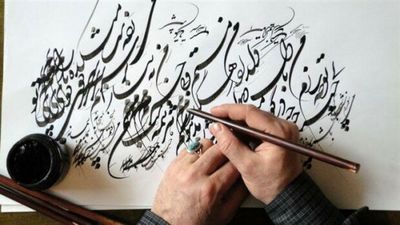During their annual meeting, held online from 13 to 18 December, the Intergovernmental Committee for the Safeguarding of the Intangible Cultural Heritage inscribed four elements on UNESCO’s List of Intangible Cultural Heritage in Need of Urgent Safeguarding and 39 elements on the Representative List of the Intangible Cultural Heritage, unesco.org wrote.
With the advent of technology, the tradition of Iranian calligraphy gradually declined. The safeguarding of the Iranian calligraphic tradition thus became a major concern in the 1980s, and a national programme was developed for this purpose by NGOs in collaboration with the government.
This programme aimed to expand informal and formal public training in calligraphy, publish books and pamphlets, hold art exhibitions, and develop academic curricula while promoting appropriate use of the calligraphic tradition in line with modern living conditions.
Secretary General of the Iranian National Commission for UNESCO. Hojjatollah Ayoubi congratulated the 17th registration of Iranian work on UNESCO’s List of the Intangible Cultural Heritage.
He asked all cultural centers in Iran to pay a special attention to Iranian calligraphy.
He added that “we are happy that not only our people are the creators of different types of calligraphy in the world, but also made efforts to protect their arts.”
Iran's Visual Arts Office Director Hadi Mozaffari also expressed his happiness over the inscription on the international body, emphasizing that Iranian calligraphy in all its kinds, in addition to visual beauty, enjoys an ancient and deep culture.
Despite the restrictions the COVID-19 pandemic has been placing on artistic initiatives around the world, Iranian National Commission for UNESCO, in January 2021 held a virtual festival of world calligraphy entitled ‘Dance of the Pen (Raqs-e Qalam) along the Silk Roads’ in Iran and brought together master calligraphers from over 30 countries along the historic Silk Roads and beyond showcasing their works.
Chaired by Punchi Nilame Meegaswatte, Secretary General of the National Commission of Sri Lanka for UNESCO, the Intergovernmental Committee also added four projects to the Register of Good Safeguarding Practices and allotted $172,000 from the Intangible Cultural Heritage Fund to a safeguarding project presented by Mongolia, $116,400 to a project in Djibouti and a further $266,000 to a project in Timor-Leste.
For the first time this year, the Intergovernmental Committee decided to inscribe elements from Congo, Denmark, Haiti Iceland, Federated Republic of Micronesia, Montenegro, the Democratic Republic of the Congo, Seychelles and Timor-Leste to UNESCO’s intangible cultural heritage lists which now feature 630 elements from 140 countries.

